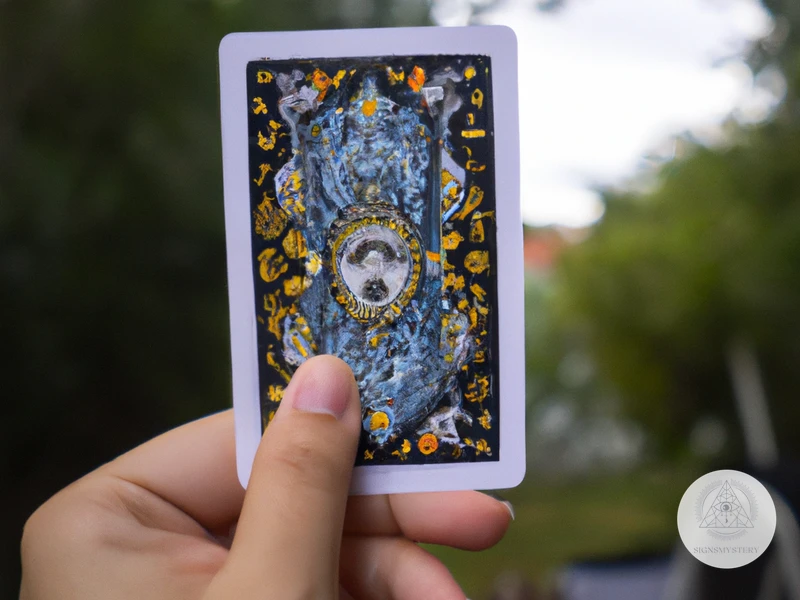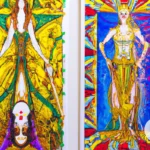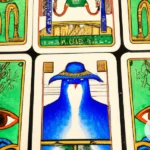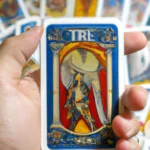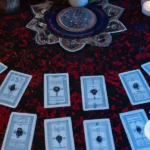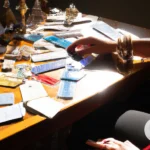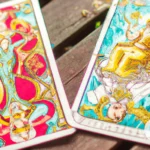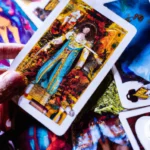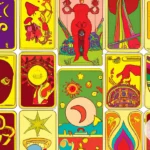Have you ever felt like you’re stuck in a rut and unable to move forward? Do you find yourself struggling with self-reflection and personal growth? You’re not alone. Many of us face similar challenges, and it’s not always easy to find the right tools to help us overcome them. That’s where Tarot Cards come in. At first glance, they might seem like nothing more than a deck of cards with pretty pictures, but they can be a powerful tool for self-reflection and personal growth. In this article, we’ll explore the history and workings of Tarot Cards, their benefits in helping you explore your inner self, how to choose the right Tarot deck, getting started with Tarot Cards, and the difference between Tarot and Oracle cards. Let’s dive in and discover the power of Tarot Cards!
What are Tarot Cards?
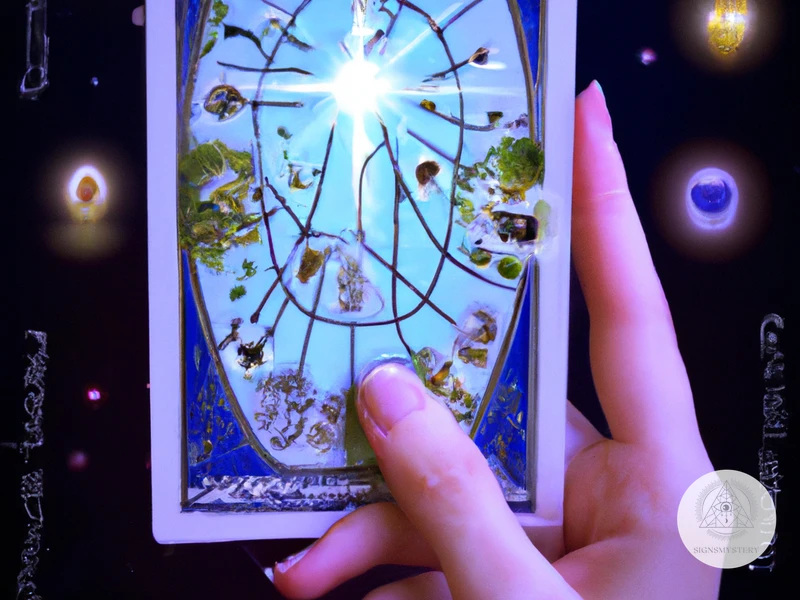
Tarot cards have been gaining popularity in recent years as a tool for self-reflection and personal growth. But for those new to tarot, it can be a bit overwhelming to understand what they are and how they work. Tarot cards are a deck of 78 cards, divided into 22 Major Arcana and 56 Minor Arcana cards, each with their own unique meanings and symbolism. The Major Arcana cards represent major life events and themes, while the Minor Arcana cards represent the more mundane aspects of life. Understanding the history and function of tarot cards can help you better utilize them for introspection and growth. To learn more about how tarot cards can help you confront and heal traumas, check out our article on Tarot Cards: Confronting and Healing Traumas.
The History of Tarot Cards
Tarot cards have a rich and mysterious history that dates back to the 15th century in Europe. The original purpose of Tarot cards was not to predict the future, but rather to play games. It wasn’t until the late 18th century that Tarot cards were first used for divination purposes.
One of the most popular theories about the origin of Tarot cards is that they were created in medieval Italy as a symbolic representation of the Hero’s Journey. This journey is a recurring theme in literature and mythology, where the hero sets out on a quest to discover their true self and return home transformed. The Tarot cards are said to reflect the different stages of this journey and provide guidance to the seeker on their own personal journey.
Over time, Tarot cards became associated with the occult, and their use for divination became more widespread. In the late 19th and early 20th centuries, several influential writers, such as Arthur Edward Waite and Aleister Crowley, created their own Tarot decks, which are still in use today.
However, the history of Tarot cards is shrouded in mystery and there are many different theories about their origins and purpose. Some people believe that they were brought to Europe by the Roma people, while others think that they were influenced by ancient Egyptian or Hebrew mysticism. Regardless of their origins, Tarot cards have become a popular tool for self-reflection and personal growth.
If you are interested in exploring the history of Tarot cards further, there are many resources available online. You can also use Tarot cards as a tool for exploring your own personal journey, such as utilizing Tarot cards for inner shadow work (check out our guide to working with the Major Arcana shadow), uncovering subconscious beliefs (learn how to use tarot cards for uncovering subconscious beliefs), and utilizing Tarot cards for Jungian shadow work (discover more about the Jungian perspective on Tarot).
How Tarot Cards Work
Tarot cards are believed to work on the principle of synchronicity, a concept famously introduced by the psychotherapist Carl Jung. Synchronicity is the experience of two or more events that are apparently unrelated or unlikely to occur together, yet are experienced as having some meaning or significance.
The Tarot cards are said to tap into the energy and vibrations of the universe, allowing for a greater understanding of oneself and the world around us. The Tarot is divided into two main groups – the Major Arcana and the Minor Arcana.
The Major Arcana consists of 22 trump cards that represent major life events, archetypal energies, and significant influences. These cards are often the focus of Tarot readings, as they offer insight into major life changes, spiritual growth, and the journey of self-discovery. Each of the cards in the Major Arcana has its own unique meaning and symbolism, and can provide guidance or inspiration to the querent (the person receiving the reading).
On the other hand, the Minor Arcana consists of 56 cards that are divided into four suits – Cups, Pentacles, Swords, and Wands. These cards represent more everyday events or situations, and can provide insight into the querent’s relationships, career, and day-to-day life. Each suit has its own set of meanings, and the cards within the suits can provide a more detailed understanding of the querent’s circumstances.
A Tarot reading involves shuffling the deck, drawing cards, and interpreting their meanings based on their position in the spread and their relationship to the other cards in the reading. The reader will often ask the querent to focus on a question or area of their life that they would like guidance on. The cards that are drawn can provide insight into the querent’s past experiences, current circumstances, and future possibilities.
It is important to note that Tarot readings are not necessarily predictive, and the future is ultimately determined by the choices and actions of the individual. Tarot readings can provide guidance, clarity, and insight, but it is ultimately up to the individual to make positive changes in their life.
Some Tarot readers also believe in the power of shadow work, which involves exploring the darker aspects of oneself and confronting issues that are often repressed or ignored. The shadow can be represented in Tarot readings by certain cards, such as the Devil or the Tower. By acknowledging and working through these shadow aspects, individuals can gain a deeper understanding of themselves and their motivations, leading to personal growth and healing. To learn more about shadow work and how to incorporate it into your Tarot practice, check out our Shadow Work Spread Tarot Reading Guide and Shadow Work Tarot Minor Arcana Guide.
Tarot cards work by tapping into the energy and vibrations of the universe, and providing guidance and insight into the querent’s life. A Tarot reading can offer clarity, inspiration, and empowerment for those seeking answers or guidance.
Misconceptions About Tarot Cards
There are a lot of misconceptions about Tarot cards that can sometimes deter people from using them. Here are some of the most common misconceptions:
- Tarot Cards are Evil: This is a common misconception that Tarot cards are associated with the devil or evil spirits. However, Tarot cards are simply a tool for gaining insight into oneself and the world around them. They have no inherent power or ability to summon demonic entities. In fact, many people use Tarot cards as a means of connecting with their higher power or spirituality.
- Tarot Cards Can Predict the Future: While Tarot cards can provide insight into potential outcomes based on present circumstances and past experiences, they do not provide a definite prediction of the future. The future is always changing based on our choices and actions, and Tarot cards are simply a tool for exploring potential outcomes and gaining clarity.
- Tarot Cards are Only for Psychics: Another misconception is that Tarot cards are only for psychic individuals. However, anyone can learn to use Tarot cards as a tool for self-reflection and personal growth. It may take time and practice to become proficient, but anyone can benefit from using Tarot cards.
- Tarot Cards are a Form of Divination: While Tarot cards can be used as a form of divination, they are more commonly used as a means of gaining insight and guidance into oneself and the world around them. Tarot cards can be used to explore one’s inner self, identify areas in need of growth, gain clarity and insight, and empower decision making. They are a powerful tool for personal growth and self-discovery.
It’s important to approach Tarot cards with an open mind and a willingness to explore oneself and the world around them. By dispelling these misconceptions, one can fully embrace the power and potential that Tarot cards hold for self-reflection and personal growth. However, it’s also important to be aware of the potential shadow side or negative aspects that Tarot cards can bring up, which can be explored through the Major Arcana Shadow Work (/exp-major-arcana-shadow/).
How Tarot Cards Can Help You With Self-Reflection and Personal Growth
Have you ever felt stuck and unsure of yourself? Do you struggle with making decisions or identifying areas that need improvement? Tarot cards can be a powerful tool for self-reflection and personal growth. By tapping into your subconscious mind and intuition, Tarot cards can help you explore your inner self, gain clarity and insight, and make empowered decisions. In this section, we will delve into how Tarot cards can benefit your personal growth and provide practical tips on using them effectively.
Exploring Your Inner Self
Tarot cards are a powerful tool for self-reflection and personal growth. One of the ways that tarot cards can help you is by exploring your inner self and gaining a deeper understanding of your thoughts, emotions, and behaviors.
When you use tarot cards for self-discovery, you are embarking on a journey of introspection and self-awareness. The images, symbols, and archetypes depicted in tarot cards can help you tap into your subconscious mind and bring to light things that may otherwise be hidden or suppressed.
Through tarot readings, you can identify patterns or tendencies that may be impacting your life, both positively and negatively. For example, you might realize that you are stuck in a cycle of self-doubt or negative self-talk, or you might become aware of aspects of your personality that you didn’t realize were holding you back.
By uncovering these hidden aspects of yourself, you can begin to address them and work towards personal growth and healing. This might involve changing your thoughts or behaviors, seeking therapy or counseling, or engaging in self-care practices.
One of the keys to exploring your inner self through tarot cards is to approach the cards with an open mind and a willingness to honestly confront your feelings and thoughts. It’s important to remember that tarot cards are a tool for self-discovery, not a magic solution to all of your problems.
To get started with exploring your inner self through tarot cards, consider setting aside some dedicated time for self-reflection and tarot readings. Keep a tarot journal to record your insights and observations, and practice incorporating tarot cards into your daily routine. With time and practice, you can use tarot cards to gain a greater understanding of yourself and work towards personal growth and healing.
| Benefits of Exploring Your Inner Self with Tarot Cards |
|---|
| Identify patterns or tendencies impacting your life |
| Address hidden aspects of yourself |
| Create change in your thoughts or behaviors |
| Gain a deeper understanding of your thoughts, emotions, and behaviors |
| Engage in self-discovery and self-awareness |
Identifying Areas in Need of Improvement
Tarot cards can also be a powerful tool for identifying areas in our lives that may need improvement. The cards can be a mirror to our inner selves, showing us aspects of our personality or behavior that we may not have been aware of. When we approach a tarot reading with an open mind and a willingness to receive guidance, we allow the cards to reveal things to us that we may have been hiding from ourselves.
Here are some ways in which tarot cards can help us identify areas for improvement:
- Highlighting patterns: Tarot cards can show us patterns in our lives that we may not have noticed before. Perhaps we keep attracting toxic relationships, or maybe we have a tendency to self-sabotage. The cards can bring these patterns to our attention and help us break free from them.
- Revealing blind spots: We all have blind spots – aspects of ourselves that we can’t see because they’re too close to our own experience. Tarot cards can reveal these blind spots to us and help us see ourselves more clearly.
- Offering guidance: When we’re feeling lost or unsure of our direction in life, tarot cards can provide us with guidance. The cards can highlight areas where we may be holding ourselves back, and point us in the direction of growth and healing.
- Fostering self-awareness: Self-awareness is a key component of personal growth, and tarot cards can help us develop it. By reflecting on the cards and what they mean to us, we can learn more about ourselves and our motivations.
- Encouraging honest reflection: Sometimes we need a gentle push to look at ourselves honestly and objectively. Tarot cards can provide that push, encouraging us to confront difficult truths and make positive changes.
It’s important to approach a tarot reading from a place of curiosity and openness, rather than looking for specific answers or solutions. The cards are a tool for self-discovery, not a magic bullet. By using them to identify areas in need of improvement, we can take the first step towards personal growth and transformation.
Gaining Clarity and Insight
Another powerful way tarot cards can help you with self-reflection and personal growth is by gaining clarity and insight. Tarot can offer a fresh perspective on situations or challenges you are facing, giving you the clarity you need to make informed decisions.
The following are some ways tarot can help you gain clarity and insight:
- Seeing a situation from a different angle: When you approach a tarot reading with an open mind and a willingness to receive guidance, you might find that the cards offer a new way of looking at a situation. You may have been feeling stuck or confused, but the cards can help you see the situation in a different, more beneficial light.
- Discovering hidden influences: Tarot can reveal underlying emotions, motivations, and beliefs that you might not have been aware of. These hidden influences can be affecting your decisions and actions, but with the help of tarot, you can become aware of them and work to address them.
- Providing advice: Tarot offers advice and guidance to help you make informed decisions. The cards can help you see the long-term consequences of your choices and actions, and offer suggestions for the best path forward.
- Highlighting strengths and weaknesses: Through a tarot reading, you can gain insight into your strengths and weaknesses. This can help you make better use of your strengths and work on improving areas where you may be struggling.
- Encouraging introspection: Tarot encourages introspection and self-reflection. Through asking questions and contemplating the cards, you can gain deeper insights into yourself and your situation.
By gaining clarity and insight through tarot, you can make more informed decisions, work through challenges, and gain a better understanding of yourself and your place in the world.
Empowerment and Decision Making
Tarot cards can be a powerful tool for self-reflection and personal growth, especially when it comes to empowerment and decision making. Through the practice of tarot reading, individuals can tap into their inner wisdom and intuition to gain insight and clarity into their lives.
One of the ways tarot can foster empowerment and decision making is through the process of identifying and exploring one’s own strengths and weaknesses. The cards can assist in bringing awareness to certain areas in which an individual may excel or struggle, allowing them to make more informed decisions and take action based on their personal values and goals.
In addition to self-awareness, tarot readings can also provide a sense of validation and encouragement towards the pursuit of one’s aspirations. A skilled reader can provide guidance and support in a way that is empowering, allowing the individual to tap into their own inner strength and intuition.
Through the use of tarot affirmations and visualizations, individuals can also strengthen their sense of self-worth and confidence. These practices can be used to build positive self-talk and mindset, ultimately leading to more empowered decision making.
Table:
| Ways tarot can empower decision making: |
|---|
| Identification of personal strengths and weaknesses |
| Increased self-awareness and informed decision making |
| Validation and encouragement of personal aspirations |
| Building positive self-talk and mindset through affirmations |
| Strengthening sense of self-worth and confidence |
In essence, tarot cards can be a valuable tool for individuals seeking to make more empowered decisions in their lives. Through the process of self-reflection and exploration, individuals can gain insight and clarity into their own strengths and challenges, ultimately leading to more informed and self-affirming decision making.
Positive Affirmations
Tarot cards are not only a powerful tool for self-reflection and personal growth, but they can also serve as a tool for positive affirmations. Positive affirmations are a way of reprogramming the subconscious mind by repeating positive statements to oneself. Tarot cards can help in this practice by providing guidance and insight through the use of affirmations.
One way to incorporate positive affirmations into a tarot reading is to look for cards that represent strength, courage, and positivity. Here are some examples:
| The Sun: | Represents positivity, vitality, and energized action. Use this card to affirm feelings of happiness, optimism, and confidence. |
| The Star: | Symbolizes hope, inspiration, and spiritual awareness. Use this card to affirm feelings of faith, trust, and hopefulness. |
| Strength: | Represents inner strength, resilience, and fortitude. Use this card to affirm feelings of resilience, courage, and endurance. |
| The World: | Symbolizes completion, integration, and wholeness. Use this card to affirm feelings of completion, fulfillment, and satisfaction. |
By focusing on these positive qualities and using tarot cards as a tool for affirmation, one can cultivate a more positive mindset, attract positivity into their life, and overcome negative thought patterns.
It is important to note that positive affirmations should be used in conjunction with action. It is not enough to simply recite positive affirmations without taking steps towards achieving one’s goals. The tarot cards can provide guidance and insight, but it is up to the individual to take action towards a more positive future.
Using tarot cards as a tool for positive affirmations can help to reprogram the subconscious mind and cultivate a more positive mindset. By focusing on cards that represent strength, courage, and positivity, one can affirm feelings of optimism, hopefulness, resilience, and endurance. Remember to couple positive affirmations with action in order to achieve one’s goals and cultivate a more positive future.
Keeping a Tarot Journal
One of the most valuable tools for using Tarot cards as a tool for self-reflection and personal growth is keeping a Tarot journal. Journaling allows you to track your progress and insights over time, identifying patterns and themes in your readings. Here are some tips on keeping an effective Tarot journal:
| Tip | Explanation |
|---|---|
| Consistency | The most important aspect of journaling is consistency. Set a specific time each day or week to record your readings and insights. Make it a habit so that it becomes a natural and rewarding part of your Tarot practice. |
| Record Your Questions | When starting your Tarot journal, record each question you ask before conducting a reading. This helps you to understand the context of the reading and review the questions asked in the past. |
| Record Your Interpretations | After conducting a reading, write down your interpretations of the cards drawn. This allows you to reflect on your initial thoughts and see how your interpretations may change or evolve over time. |
| Record Your Personal Response | After you have recorded your interpretation, write down what personal response it elicited. For example, did the reading make you feel inspired, nervous, or uncertain? This will help you track your emotional progress and identify any areas in need of further reflection. |
| Identify Patterns and Themes | As you record your readings and insights over time, you may begin to notice patterns and themes. Tracking these can help you identify parts of your life that may need attention or growth. For example, you may notice that whenever you feel stressed, certain cards consistently appear. This might indicate that you should focus on stress management in that area of your life. |
| Reflect on Past Readings | From time to time, review your past readings and interpretations. This will allow you to see your progress and growth over time and gain inspiration from your past insights. |
Keeping a Tarot journal can be a powerful tool in your personal growth and self-reflection journey. By tracking your progress and insights over time, you can gain insight into your emotional states and identify areas in need of improvement. Consistency is key – make journaling a habit and enjoy the benefits of its powerful insights.
Choosing the Right Tarot Deck for Yourself
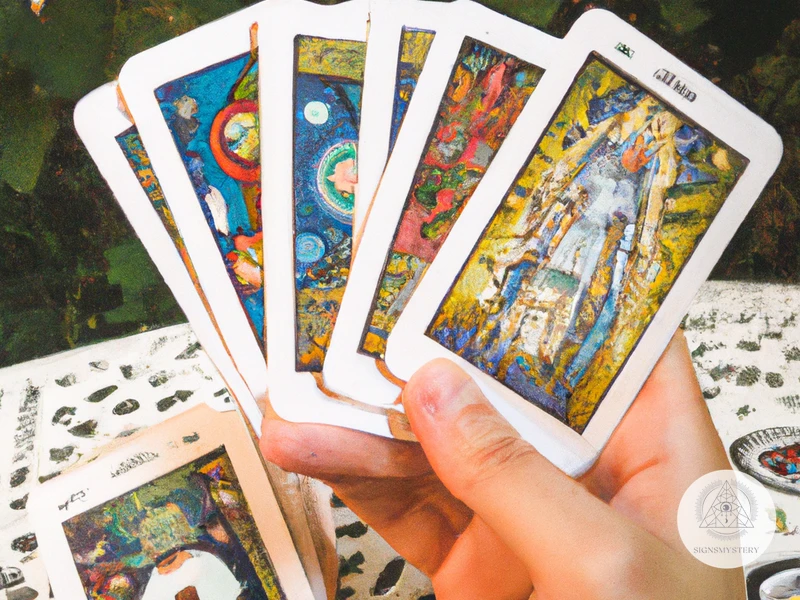
With the multitude of tarot decks available on the market, it can be overwhelming to decide on the right one for your personal practice. Each deck has its own unique aesthetic and symbolism, making it important to choose one that resonates with you and your energy. The deck you choose will be the tool you use for guidance and self-reflection, so it’s essential to select one that you feel a deep connection with. In this section, we will explore different tarot decks and provide guidance on how to choose the perfect one for your personal journey.
The Rider-Waite Tarot Deck
When it comes to tarot decks, one of the most popular and widely used is the Rider-Waite Tarot Deck. This deck was first published in 1910 and was created by artist Pamela Colman Smith and academician A.E. Waite. The Rider-Waite Tarot Deck is known for its intricate and detailed imagery, as well as its rich symbolism.
The Major Arcana:
The Major Arcana cards in this deck feature iconic images such as The Fool, The High Priestess, The Lovers, and The Wheel of Fortune, all of which hold significant meaning and are interpreted in various ways depending on the individual reading the cards.
The Minor Arcana:
The Minor Arcana cards are divided into four suits: Cups, Swords, Wands, and Pentacles. Each suit represents a different element (water, air, fire, and earth, respectively) and includes cards numbered from Ace to 10, as well as four court cards (Page, Knight, Queen, and King).
The Imagery:
One of the reasons why the Rider-Waite Tarot Deck is so popular is due to its detailed and intricate imagery. For example, The Fool card shows a figure walking towards the edge of a cliff, with a small white dog at his feet. This imagery represents the idea of taking a risk or leap of faith, and relying on one’s intuition rather than logic or reason.
The Symbolism:
Another reason why this deck is so renowned is because of its rich symbolism. Each card in the deck represents a different aspect of life, and can be interpreted in numerous ways. For instance, The Tower card depicts a tall tower being struck by lightning, which can symbolize sudden upheaval and destruction, or a necessary breakdown before a breakthrough.
The Rider-Waite Tarot Deck is a powerful tool for those looking to gain insight into their own lives and explore their inner selves. Whether you’re a beginner or a seasoned tarot reader, this deck is an excellent choice for anyone interested in the world of tarot.
Thoth Tarot Deck
One of the most unique and visually stunning tarot decks available is the Thoth Tarot Deck. Designed by the famous English occultist, Aleister Crowley in the early 1900s, this tarot deck has become synonymous with the occult and esotericism.
The Thoth Tarot Deck consists of 78 cards divided into two main groups, the Major Arcana and the Minor Arcana. The Major Arcana consists of 22 cards, each of which represents an archetypal figure or concept. The Minor Arcana consists of 56 cards, which are divided into four suits- Wands, Cups, Swords, and Pentacles- each representing a different aspect of human experience.
What sets the Thoth Tarot Deck apart from other tarot decks is the incredible attention to detail and symbolism that Crowley incorporated into each card. The artwork, done by Lady Frieda Harris, perfectly captures the meanings and essences of each card, making it easier for the reader to interpret and understand.
Some of the standout cards from this deck include The Magus, The Priestess, The Emperor, and The Star. Each card is designed with intricate symbols and colors that
Subscribe to Our Newsletter
Sign up to receive the latest news and updates.
However, it is worth noting that the Thoth Tarot Deck may not be suitable for beginners or those who are uncomfortable delving into more esoteric and complex symbolism. It requires a deep understanding of occultism and esotericism to fully appreciate its intricacies.
The Thoth Tarot Deck is a beautifully crafted and highly symbolic deck that combines the genius of Aleister Crowley with the artistry of Lady Frieda Harris to create a truly unique and powerful tool for divination and self-discovery.
Choosing Other Decks
When it comes to selecting a tarot deck, there are countless options available aside from the well-known Rider-Waite and Thoth tarot decks. Choosing the right deck is a personal decision that should be based on several factors, such as your personal taste and preferences, the cultural background of the deck, the style and symbolism used in the cards, and the artist behind the illustration.
Here are some of the popular options to choose from:
- The Wild Unknown Tarot: This modern and minimalist deck features simple yet powerful illustrations that connect with nature and the animal kingdom.
- The Shadowscapes Tarot: This deck presents a beautiful blend of fantasy and mythology, with intricate and dreamy watercolor illustrations that evoke a sense of magic and whimsy.
- The Everyday Witch Tarot: As the name suggests, this deck is centered around the theme of witchcraft and features playful and colorful illustrations that are fun and approachable.
- The Deviant Moon Tarot: For those drawn to darker and more surreal imagery, this deck offers a unique twist on traditional tarot symbolism with haunting and otherworldly illustrations.
- The Fountain Tarot: This deck is known for its sleek and modern design, with crisp and vibrant illustrations that depict urban scenes and contemporary situations.
But remember, no matter which deck you choose, it’s important to take the time to connect with it and understand the symbolism and meaning behind each card. This can greatly enhance your tarot reading experience and help you gain deeper insights into your inner self.
Getting Started with Tarot Cards
So, you’ve decided to take the plunge into the fascinating world of tarot cards. Congratulations! But, where do you begin? Getting started with tarot cards can seem overwhelming, especially if you’re new to the practice. Rest assured, this section will guide you through the steps of learning to read tarot cards, cleansing and protecting your deck, and preparing yourself for a tarot reading. Whether you’re interested in tarot for personal growth, spiritual development or simply for fun, this guide will give you the confidence you need to begin your tarot journey.
Learning to Read Tarot Cards
Reading tarot cards may seem overwhelming at first, but with practice and patience, anyone can learn to decipher their meaning. Here are some steps to get started:
| Step | Description |
|---|---|
| 1 | Get to know your tarot cards: Tarot decks typically include 78 cards, each with its own unique image and meaning. Take time to familiarize yourself with each card, paying attention to the symbolism and associations. |
| 2 | Start with simple spreads: A spread is a layout of cards that gives insight into a specific topic or question. Begin with a three-card spread, such as past-present-future or mind-body-spirit. Don’t worry about memorizing the meanings of each card right away; simply lay them out and see what comes to mind. |
| 3 | Practice regularly: The more you use your tarot cards, the more comfortable you will become with them. Consider doing a daily card pull to gain insight into your day or to reflect on a specific topic. |
| 4 | Trust your intuition: Tarot is a tool for self-reflection and personal growth, and ultimately, the interpretation of the cards comes down to your own intuition and inner wisdom. Pay attention to your initial thoughts and feelings when reading a card, and don’t be afraid to trust your own instincts. |
| 5 | Continue learning: Tarot is a vast and complex subject, and there is always more to learn. Consider reading books or taking courses on the topic, or connecting with a tarot community for support and guidance. |
Remember, the key to reading tarot cards is to approach them with an open mind and a willingness to learn. With dedication and practice, using tarot cards can become a powerful tool for personal growth and self-reflection.
Cleansing and Protecting Your Deck
When it comes to working with tarot cards, it is important to keep your deck cleansed and protected. Not only does this ensure that the energy of the deck remains clear and accurate, but it also helps to cultivate a deeper connection with the cards. Here are some ways to cleanse and protect your deck:
| Method | Description |
|---|---|
| Salt | One of the most popular ways to cleanse your deck is to sprinkle a small amount of salt onto the cards and then use your hands to shuffle them. The salt absorbs any negative energy that may be lingering on the cards. |
| Smudging | Smudging involves burning sage or other herbs and using the smoke to cleanse the cards. Hold the cards in the smoke and visualize any negative energy being released. |
| Moonlight | Place your deck under the light of the full moon overnight. The moon’s energy will help to cleanse and charge the cards. |
| Sound | Use a singing bowl, bell, or chimes to create sound vibrations that will help to clear any negative energy from your deck. |
| Intention | Simply setting the intention that your deck is cleansed and protected can be enough to clear away any negative energy. Visualize a bright light surrounding your deck and affirm that it is protected from any negativity. |
It is also important to store your deck in a safe and sacred space when not in use. Some people choose to wrap their deck in a cloth, while others keep them in a special box or bag. Whatever method you choose, make sure that your deck is protected from any negative energy or outside influences. By taking care of your deck, you can ensure that it will continue to provide you with accurate and insightful readings for years to come.
Preparing Yourself for a Tarot Reading
When preparing for a tarot reading, it is important to create a calm and focused mindset. Here are some steps you can take to help prepare yourself:
- Clear your mind: Before beginning a tarot reading, take a few deep breaths and try to clear your mind of any distractions or worries.
- Set your intention: Think about why you want to do the reading and what you hope to gain from it. This will help guide the focus of the reading.
- Choose a quiet space: Find a quiet, comfortable space where you won’t be disturbed. This will help you focus on the cards and your intuition.
- Choose a time: Pick a time when you are feeling relaxed and focused. Avoid doing a reading when you are feeling distracted or stressed.
- Shuffle the cards: Shuffle the cards thoroughly and focus on your intention while shuffling. You can ask a specific question or simply ask for guidance in a particular area of your life.
- Draw your cards: When you feel ready, draw your cards and lay them out in the chosen spread. Take your time looking at each card and trying to connect with its meaning and message.
- Keep an open mind: Remember that the cards are simply a tool for guidance and self-reflection. They do not have all the answers and should not be relied on as the final authority. Keep an open mind and trust your own intuition.
By following these steps and preparing yourself mentally and emotionally for a tarot reading, you can gain greater clarity and insight into your life, while also cultivating your own intuitive abilities.
Tarot Cards vs Oracle Cards
For those unfamiliar with divination tools, it can be challenging to differentiate between various card decks, such as tarot and oracle cards. While they share a common ground and are often used interchangeably, they have distinct characteristics and purposes. Understanding the differences between these tools is crucial for selecting the one that resonates with you and your goals. In this section, we’ll explore the nuances between tarot and oracle cards, helping you make an informed decision about which one to use.
The Difference Between Tarot and Oracle Cards
When it comes to divination tools, it’s easy to get confused or even overwhelmed by the variety of options available. Two popular tools for self-reflection and personal growth are Tarot Cards and Oracle Cards. Although they may seem similar at first glance, there are some key differences between these two types of cards.
Tarot Cards
Tarot cards typically consist of 78 cards, divided into the Major Arcana and Minor Arcana. Each card has a unique image and meaning, with the Major Arcana focusing on major life events and the Minor Arcana addressing daily events and challenges. Tarot cards are often associated with fortune-telling, but they can also be a powerful tool for self-reflection and personal growth.
Oracle Cards
Oracle cards, on the other hand, can come in various sizes and types and have no fixed number of cards. Unlike Tarot cards, Oracle decks don’t have a standardized set of cards or meanings. Each card in an Oracle deck is unique and stands on its own. Oracle cards are often used to provide inspiration, guidance, and advice for daily life.
The Difference Between Tarot and Oracle Cards
The main difference between Tarot cards and Oracle cards lies in their structure and purpose. Tarot cards have a fixed set of cards and meanings, while Oracle cards can have any number of cards and can cover a wide range of topics. Tarot cards are typically more structured and suitable for addressing specific questions or concerns, while Oracle cards are more flexible and can be used for different purposes.
Another key difference is in the way the cards are interpreted. Tarot cards rely heavily on symbolism and archetypes, and each card has a specific meaning and interpretation. Oracle cards, on the other hand, may rely more on intuition and personal insights, with each card serving as a starting point for reflection and self-discovery.
While both Tarot and Oracle cards can serve as powerful tools for self-reflection and personal growth, they differ in their structure, purpose, and interpretation methods. The best way to choose between the two is to consider your individual needs and preferences and choose the one that resonates with you the most.
Choosing Between Tarot and Oracle Cards
When it comes to choosing between tarot and oracle cards, there are a few key differences to consider. While both types of cards can be used for self-reflection and personal growth, they have distinct characteristics that may make one more appealing than the other depending on your personal preferences and goals.
Tarot Cards are known for their detailed and structured system of symbolism and meanings. They typically consist of 78 cards divided into the Major Arcana (22 cards that represent archetypal experiences and themes) and Minor Arcana (56 cards that represent everyday experiences and influences). Each card has a specific meaning, and the cards are drawn and read in a specific pattern or spread to gain insight and guidance on particular questions or situations.
Oracle Cards, on the other hand, have a looser and more flexible system of symbolism and meanings. They can be any number of cards (usually between 30 and 60) and can have any theme, from angels and fairies to nature and animals. The cards are typically designed to be more uplifting and inspirational, offering positive messages and affirmations rather than detailed insights and guidance. They can be drawn and read in any pattern or spread, and are often used to offer general guidance and support.
To help you decide which type of cards may be right for you, consider the following factors:
| Tarot Cards | Oracle Cards | |
|---|---|---|
| Complexity | Tarot cards have a more complex system of symbolism and meanings, which can offer deeper insights and guidance. | Oracle cards have a simpler and more flexible system of symbolism and messages, which can be more uplifting and inspirational. |
| Theme | Tarot cards typically have a broader range of themes and can cover more complex and challenging topics. | Oracle cards are often designed around specific themes, such as angels or nature, and may be more focused on positive messages and affirmations related to those themes. |
| Personal Style | Tarot cards may be more appealing to those who enjoy detail-oriented systems and structured guidance. | Oracle cards may be more appealing to those who prefer a more intuitive and free-form approach to guidance. |
| Goal | If your goal is to gain detailed and specific insights and guidance on a particular question or situation, tarot cards may be more appropriate. | If your goal is to gain general guidance, inspiration, and positive messages, oracle cards may be more appropriate. |
Ultimately, the choice between tarot and oracle cards comes down to personal preference, style, and goals. Both types of cards can be powerful tools for self-reflection and personal growth, so experiment with both and see which resonates with you the most.
Conclusion
In conclusion, tarot cards can be a powerful tool for self-reflection and personal growth. By exploring your inner self, identifying areas in need of improvement, gaining clarity and insight, and empowering yourself to make decisions, tarot cards can help you achieve personal transformation and positive change.
There are many misconceptions about tarot cards, but it’s important to remember that they are not a supernatural or magical tool. Rather, tarot cards are a tool for introspection and self-exploration. Through tarot readings, you can gain valuable insights into your own psyche and personal journey.
When choosing a tarot deck, it’s important to find one that resonates with you and your own personal style. Whether you choose the Rider-Waite Tarot Deck, Thoth Tarot Deck, or some other deck entirely, it’s important to find one that speaks to you and your own unique needs.
Learning to read tarot cards can be a complex process, but with practice and dedication, you can develop your skills and use tarot cards to achieve personal growth and transformation. It’s important to cleanse and protect your deck, as well as prepare yourself mentally and emotionally for a tarot reading.
Finally, it’s important to note that tarot cards are not the same as oracle cards. While both can be used for personal reflection and growth, they have different origins, structures, and meanings. It’s important to choose the right tool for yourself and your own unique needs.
Overall, tarot cards can be an invaluable tool for those seeking personal transformation and growth. By exploring your inner self and gaining valuable insights, you can achieve greater awareness and empowerment in your life. So why not give tarot a try and see what insights you can gain from this fascinating tool?
Frequently Asked Questions
What should I do if I get a negative or frightening tarot card during a reading?
Take a deep breath and remember that tarot cards are simply a tool for self-reflection and personal growth. If a card makes you feel uncomfortable, take some time to explore why that may be and how it applies to your current situation. Consider seeking the guidance of a professional reader for additional support.
Can you only use tarot cards for personal growth and reflection?
No, tarot cards can also be used for divination and gaining insight into future events. However, it’s important to remember that the future is not set in stone and tarot readings should be taken with a grain of salt.
What are some common misconceptions about tarot cards?
Some people believe that tarot cards are used for evil or magical purposes, when in reality they are simply a tool for self-reflection and personal growth. It is also a misconception that only certain people can read tarot cards – anyone can learn how to use them.
Can tarot cards predict the future?
Tarot cards can provide insight into potential future events, but they do not predict the future with absolute certainty.
How do I choose the right tarot deck for myself?
Consider the imagery and symbolism of the deck, as well as your personal connection to the artwork. You may also want to research different decks and read reviews before making a decision. Trust your intuition and choose a deck that speaks to you.
Do I need to have psychic abilities to read tarot cards?
No, you do not need to have psychic abilities to read tarot cards. Reading tarot cards is a skill that can be learned and improved upon with practice.
How do I cleanse and protect my tarot cards?
You can cleanse your tarot cards by smudging them with sage or palo santo, placing them in moonlight or sunlight, or using a ritual such as visualization or intention-setting. To protect your cards, you may want to store them in a protective case or cloth and avoid letting others handle them.
What is the difference between tarot cards and oracle cards?
Tarot cards typically have a structured set of cards with a specific meaning, while oracle cards can have any number of cards with varying meanings. Tarot cards also typically follow a specific system of Major Arcana and Minor Arcana cards, while oracle cards may have a unique structure or theme.
Can I use multiple tarot decks in one reading?
While it is possible to use multiple tarot decks in one reading, it may be more beneficial to stick with one deck in order to develop a deeper connection and understanding of its meanings.
Do I need to be in a certain state of mind to do a tarot reading?
It can be helpful to be in a calm and focused state of mind when doing a tarot reading, but it is not necessary. Some people find that doing a brief meditation or grounding exercise before a reading can help them to connect more deeply with the cards.

